
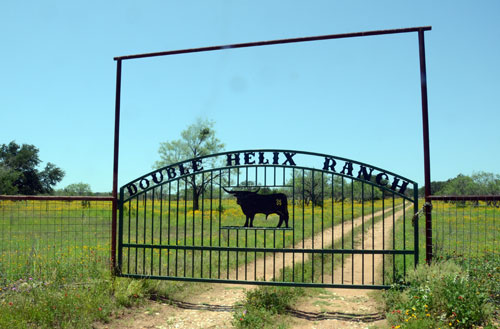

Cows | Bulls | Heifers | Calves | Horn length | Coloration | Inbreeding | Ranch sites | Brand explanation | Links
Explanation of the Double Helix Ranch brand, freeze-branding versus fire-branding,
instructions for freeze branding cattle, and advice on designing a new brand



The brand of the Double Helix Ranch is a stylized rendition of the DNA molecule: the molecule that encodes all genetic traits in all living organisms. The two strands of the double helix of DNA are formed from long chains of four nucleotides: adenine, guanine, cytosine, and thymine. These four nucleotides are the "letters" of the DNA language, and each triplet of three adjacent nucleotides encodes a codon or "word" that specifies a particular amino acid. Amino acids, in turn, are the building blocks of proteins, and proteins form the basis of biological structure and function. By sequencing the long strings of nucleotides that form each strand of DNA's double helix, biologists are learning to read the genetic instructions that specify what an organism looks like and how it functions.
Below is a more detailed model of DNA. As you can see, the brand is highly stylized.

At the Double Helix Ranch, we prefer to use freeze-branding techniques to brand our cattle. We have found freeze branding to be as permanent as fire branding, and is more humane, less stressful, and causes no damage to the skin. We also find the brands to be more readable, with little chance of scarring or blotching. Typically, freeze branding destroys melanocytes, and thus causes the hair to grow back white after the branded animal sheds its coat. On white-haired animals, freeze brands are still visible, but they must be applied longer to prevent or modify hair-growth. Interestingly, a freeze brand on a roan animal often results in hair of the darker underlying color against a mostly white background (see below, upper right). We have had no trouble getting a highly readable and permanent freeze brand even on all-white cattle. Here are a few examples of what freeze brands look like:
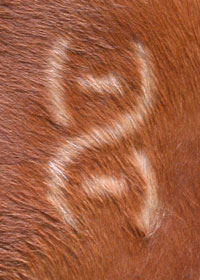
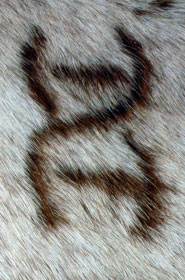

So why do most U.S. cattlemen prefer fire-branding to freeze-branding? Tradition plays the largest role, but there are a few other reasons as well. First, freeze branding works best if the branding irons are made from bronze or copper rather than steel (the usual choice for fire brands), because steel warms up too quickly. [Regarding the choice of bronze versus copper brands for freeze-branding: I'd recommend bronze, because it is more durable, and can also be used for fire-branding if needed.] Although the price is similar for brands made of any of these materials (if ordered from a commercial source), people who make their own brands are much more likely to work with steel than with bronze or copper. Also, if a rancher already owns a set of fire brands, then there is additional expense in obtaining a new set of freeze brands. Second, there is an added expense of the coolant to chill the brands. We use liquid nitrogen to cool the brands, but some people prefer to use a mix of crushed dry ice and alcohol (because of the availability and ease of transport of dry ice). For ranchers who keep liquid nitrogen for semen storage already, this is a minor expense, but otherwise transporting and storing liquid nitrogen requires a special liquid nitrogen tank, which is an another added expense. The cost and availability of dry ice or liquid nitrogen vary considerably, and in some areas obtaining either may be difficult. Third, freeze branding takes a little more time than fire branding. For operations that are branding hundreds of animals in a day, the time difference can be considerable. The fourth argument I've heard against freeze branding is that the brand is not always highly visible immediately after it has been applied; the white hair does not develop until the animal sheds. However, this last argument is usually an indication of minimal experience with freeze branding. If immediate identification is important, then the freeze brand can be applied a little longer and the brand will be highly visible from day one. I'm convinced that freeze brands produce better, clearer, more readable brands than do fire brands, and cause less damage to the skin and much less stress to the animal. Causing less stress to your animals is not only more humane, it also makes handling animals much easier and keeps them from becoming shy about entering the cattle pens or loading. However, it is true that freeze-branding requires a little more time and expense, and the coolant (dry ice or liquid nitrogen) may not be easily available in some areas.
The procedure for freeze-branding is straightforward. As with fire-branding, the cattle to be branded must be restrained. Although the cattle do not react nearly as strongly to freeze-branding as they do to fire-branding, the irons must be held in place longer with freeze branding, so immobilization in a squeeze chute is important. However, since the cattle usually remain calm and do not react strongly to the freeze brands (certainly much less so than with hot brands), a simple two-gate chute with a leg tied to one gate is usually sufficient:
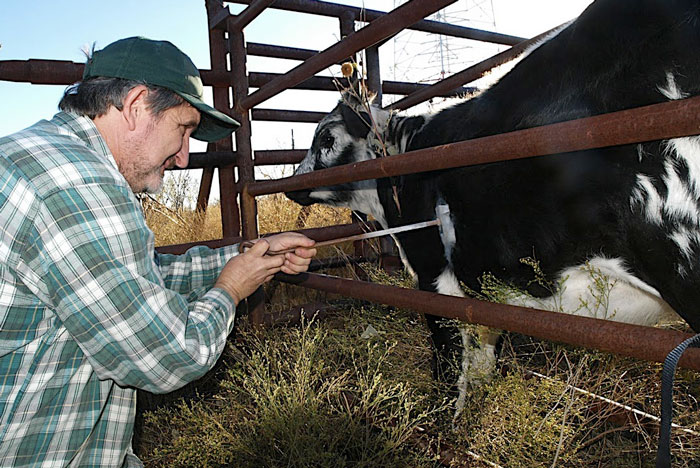
Thanks to Larry Gilbert for this photo of freeze branding cattle at the Double Helix Ranch
Pour the coolant (the liquid nitrogen or a mixture of crushed dry ice and alcohol) into a small styrofoam ice chest, and place the branding irons in the coolant for a minute or so (until the mixture stops boiling):
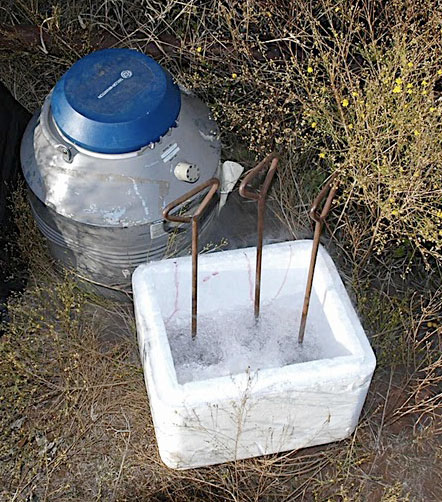
Freeze brands cooling in liquid nitrogen; photo by Larry Gilbert.
Clip the area to be branded (especially if the hair is long) to achieve the best freeze brand, using electric hair clippers. Wet the brand site with alcohol (ethanol or isopropanol), and then quickly remove the brand from the coolant and apply to the site. The alcohol on the skin is important to ensure adequate freezing.
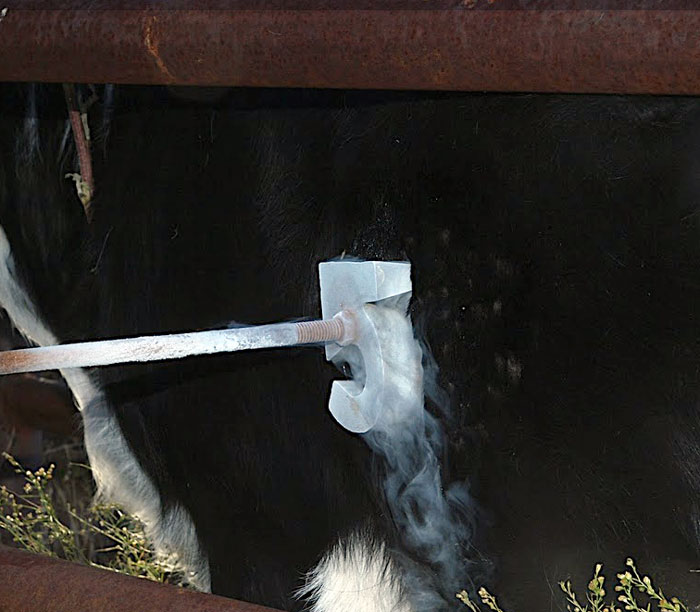
Hold the freeze brand tighly against the skin, with a slight rocking motion. Photo by Larry Gilbert.
Hold the brand tightly against the skin, with a little rocking to ensure good contact. The length of application of the brand will depend on two factors: the age of the animal and desired effect of the branding. For colored (non-white) calves, 30 seconds of brand application is adequate. This time should be increased for older animals with thicker skin, and on animals with white hair (45 seconds to one minute). The branded area will initially be frozen, and then will swell slightly as it thaws. These areas will grow back with white (or differently colored) hair after the animal next sheds. If the brand is held on for longer periods, then the surface of the skin will be lost and the hair will not re-grow. In this latter case, the brand will look more like an exceptionally crisp and clear traditional fire brand, but without any deep damage to the hide.
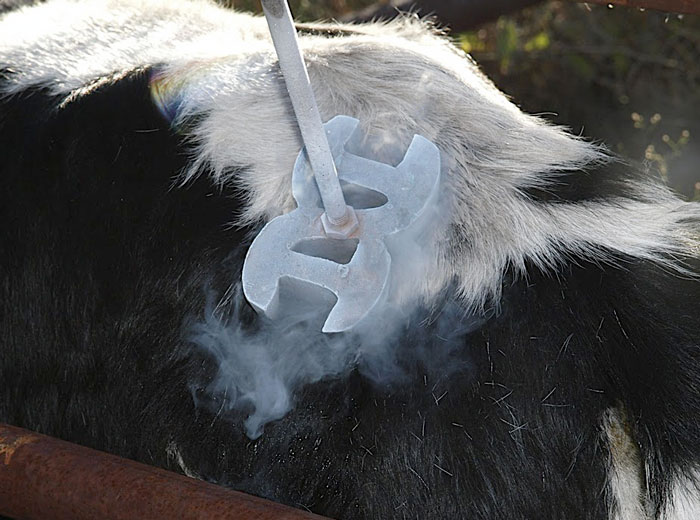
When freeze-branding on white hair, hold the brand on the animal for 45 seconds. Photo by Larry Gilbert.
If you are designing a new cattle brand, I have a few words of advice. First, keep it simple. Large, complex brands are hard to apply, rarely produce a satisfactory brand, and result in considerable damaged tissue. Second, if designing a fire brand, you should avoid closed loops, such as occur in the letters A, D, O, P, Q, and R, or in the numbers 6, 8, 9, and 0, as the entire area within the closed loop is likely to blotch and scar. This is not a problem with freeze brands, however. Third, avoid touching or crossing lines. For instance, if you want an X in your brand, leave a gap where the lines cross. This will also reduce problems with blotching (again, this is primarily a problem for fire brands). The worst brands are the ones that violate all three of these principles (such as a complex design that involves a combination of crossing lines within a closed circle). Such brands are nearly impossible to apply without making a blotchy, unreadable mess, particularly if fire branding is used.
Before you have your brands made, you will want to check with your state and with your breed association about registration of the brand. Different states have different regulations, and in Texas all brands are registered on a county by county basis. Therefore, in Texas you will need to register your brand in each county where you expect to keep or market cattle, and you will need to renew the registration every 10 years. Some other states register brands on a statewide basis. In addition, most breed associations will require you to register your brand, and it may need to be unique within the breed organization as well as in your state or county.

Registered Texas Longhorns are branded with a holding brand that identifies the breeder (e.g., our Double Helix brand) as well as a private herd number that identifies the individual animal. Different systems are used by different ranches for assigning private herd numbers. In our case, the first number (or two for animals born in October through December) indicates the month of birth, the second number indicates the order of birth of calves within a given month, and the last number indicates the year. Thus, the private herd number 529 on D-H Cinco de Mayo (above) indicates that he was our second calf born in May of 2009.
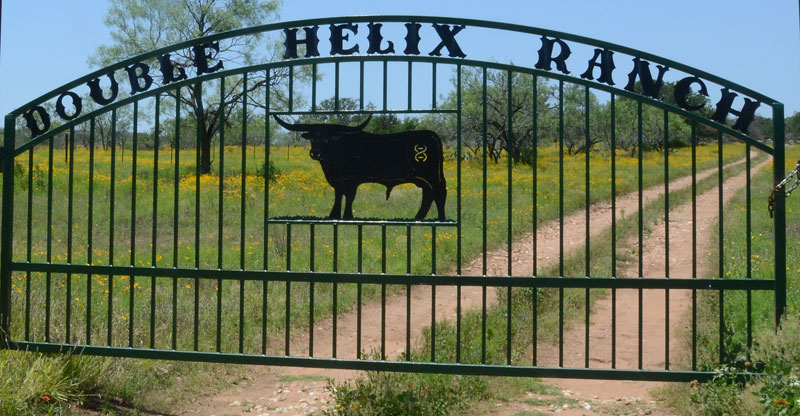
As a final note, our brand has been reproduced in many places. It appears in several posters and paintings of famous cattle brands. Perhaps the most unusual place it appears is in the upper windows of the Neural Molecular Sciences Building on the University of Texas at Austin campus, where it was used as the basis for the artistic window etchings:

Best wishes and good luck from the Double Helix Ranch!
Cows | Bulls | Heifers | Calves | Horn length | Coloration | Inbreeding | Ranch sites | Brand explanation | Links